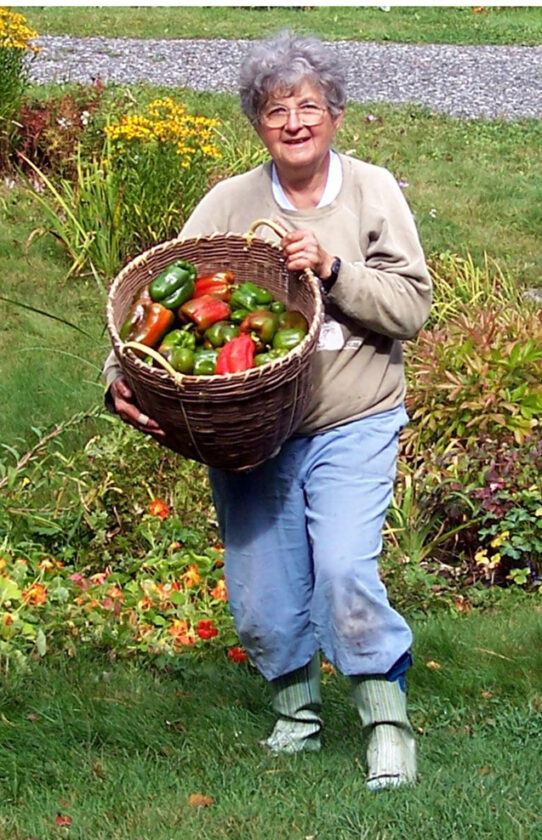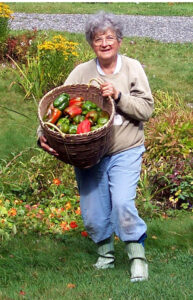Pepper Harvest

Harvesting peppers. (Provided photo — Yvona Fast)
It should have remained green. So why has it changed color, this red pepper? — Matsua Basho (1644-1694), from Haiku, on poetry written for popularity
Colorful, glossy sweet bell peppers in a rainbow of colors resemble Christmas tree ornaments: red, yellow, orange, purple, brown, black and green. When raw, they are crisp, tangy and bright in salads and other dishes. Cooking mellows and sweetens their flavor, and the peppers become limp and lose their crunch. The milder members of the Capsicum family are known as sweet peppers because they contain a recessive gene that prevents the production of capsaicin, the substance responsible for the fiery taste of their hotter cousins like chili, jalapeno and cayenne.
Like many other vegetables, bell peppers are botanically a fruit. The color green indicates immaturity; given enough time, peppers will ripen to a myriad of vibrant colors, depending on the variety. As they do, their flavor will become sweeter and milder and the concentration of important vitamins like beta carotene will increase significantly: red bell peppers contain 11 times more beta carotene than green bell peppers! Bell peppers are also an excellent source of vitamin C: by weight, green peppers contain twice as much C as citrus fruit; red peppers, three times as much. These two powerful antioxidant vitamins help neutralize free radicals in the body, aiding in the prevention of conditions like heart disease, arthritis and asthma. To get the most vitamin C from your peppers, eat them raw. Cooking, roasting or drying substantially decreases this vitamin, which is destroyed by heat.
Peppers are also a good source of fiber, vitamin B6 and folic acid. Red bell peppers contain the phytonutrients lutein and zeaxanthin and may help protect eyes against cataracts and macular degeneration. Lycopene and Beta-cryptoxanthin, two carotenoids found in red bell peppers, may protect against certain types of cancer.
Both hot and sweet peppers have been cultivated in Central and South America for more than 7,000 years. They were used by Native Americans not only for food, but also as ornaments and medicine. Searching for the Oriental black pepper, Christopher Columbus brought capsicum back to Europe, where it quickly became a substitute for the expensive imported spice. He is responsible for misnaming the vegetable; it took botanists 200 years to discover that capsicums are not in the same plant family as piper nigrum (black pepper).
It was not until European colonists arrived that capsicums became known outside of Central America. The tropical capsicum plant has adapted to temperate climates. Once introduced to Europe, they spread quickly throughout Italy, Portugal and the Balkans, where they became an integral part of national cuisines. Today, green bell peppers are a big part of many Italian, Cajun and Creole dishes.
Portuguese traders introduced capsicums to Japan, Korea and India during the second half of the 16th century. By the time Japanese haiku poet Matsuo Basho wrote the above poem in the 17th century, capsicums were becoming popular around the globe.
Although bell peppers from California, Florida and Mexico are available in the supermarket year-round, now is the time when delicious, wholesome peppers are plentiful at area farmers’ markets.
Look for firm, heavy fruit. The skin should be smooth, not wrinkled and the stem should be fresh and green. Black or sunken spots indicate that they’re past their prime. They need cool, moist conditions to stay fresh, so store wrapped in plastic in the refrigerator.
Hot or sweet, there are many ways to use peppers. Spicy peppers like habanero, serrano, chili and jalapeno add spice to salsas, chilis and other dishes. Sweet varieties are great raw in salads and add zest to dishes from stir-fries to rice, pasta or casseroles. Throw some on top of pizza, or stuff them with a myriad of fillings, both warm and chilled.
–
Colorful Pepper Stir Fry
–
Serve as a side dish; or, combine with stir-fried meat for a main dish over grain like rice or quinoa.
–
Ingredients:
–
1 Tablespoon olive oil
1 large onion
3 bell peppers, different colors
2 teaspoons soy sauce
Prepare the vegetables. Peel the onion and cut it into rings or strips. Wash and seed peppers and cut into strips.
Heat oil in a large skillet or wok. Add onion and cook 1 to 2 minutes. Add peppers and cook 5 minutes longer, until crisp-tender. Sprinkle with soy sauce, toss to coat and cook 1 more minute. Serve.
If using meat, add strips of steak or pork to the skillet after adding the onion; then add peppers. Make sure the meat is cooked through before serving. Add a little more soy sauce at the end and some rice vinegar for a little tang, if you wish.
–
Colorful Pepper and Onion Salad
–
Ingredients:
–
1/2 teaspoon salt
1 small clove of garlic
2 teaspoons olive oil
2 Tablespoons fresh lemon juice
1 red bell pepper
1 yellow bell pepper
1 green bell pepper
1 large sweet onion
–
Directions:
–
Crush garlic with salt in a mortar and pestle. At the bottom of the salad bowl, combine olive oil, lemon juice and crushed garlic. Whisk well.
Wash and seed the peppers, and cut them into thin strips. Peel the onion and cut into thin half-rings. Toss vegetables into the dressing; stir well to combine. Allow to marinate in the dressing for at least 30 minutes. Serves four.
–
Quick Summer Harvest Squash and Pepper Skillet
–
Ingredients:
–
1 to 2 strips of bacon or 1 link Italian sausage (sweet or hot, your choice)
1 large onion
1 to 2 sweet bell peppers
1/2 to 1 hot green pepper
3 to 4 ounces diced cooked ham (omit if using sausage)
2 small or 1 medium zucchini or summer squash
1 large tomato (or several smaller)
Salt and pepper to taste
–
Directions:
–
In a large skillet on medium heat, cook bacon to render fat. When bacon is crisp and fat is rendered, remove and set aside.
While the bacon cooks, peel the onion, wash and core the peppers and dice the vegetables. Add onions and peppers to the bacon drippings, and cook on medium-low for about 15 minutes, until they are soft. Add ham, squash and tomato, sprinkle with salt and pepper and cook about 10 more minutes or until everything is cooked to the desired doneness. Crumble in the reserved bacon. Taste to adjust seasonings. Serve over pasta with a salad of fresh greens. Serves two.
Option: for a vegan version, omit meat and use olive oil for cooking. Add cooked or canned beans for protein.
— — —
Author of the award-winning cookbook Garden Gourmet: Fresh & Fabulous Meals from your Garden, CSA or Farmers’ Market, Yvona Fast lives in Lake Clear and has two passions: writing and cooking. She can be found at www.yvonafast.com and reached at yvonawrite@yahoo.com or on Twitter: @yvonawrites.



